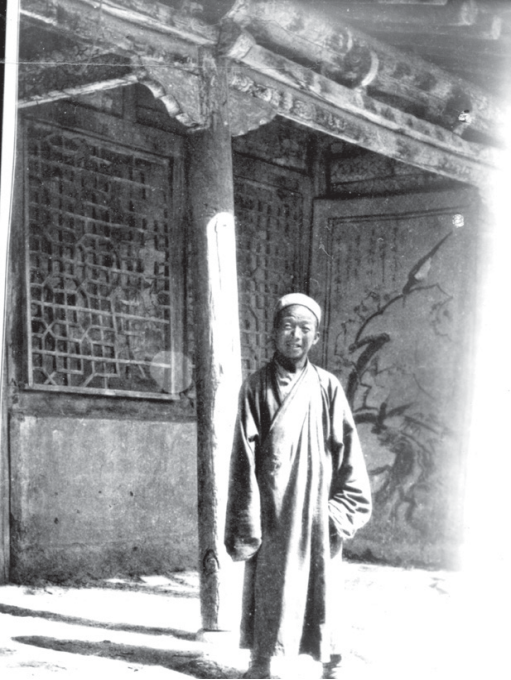
Wang Yuanlu
Wang Yuanlu (1849-1931), or Wang Tao-shih, originally from Macheng in today's Hubei Province, was named Yuanlu (圓箓), also written "園祿" with the same pronunciation. He discovered the Library Cave in Dunhuang and became a key figure in the dispersal of the texts found there. In his early years, Wang faced repeated droughts in his hometown, leading him to wander about. In the early days of the reign of Emperor Guangxu of the Qing Dynasty (1644-1911), he joined the garrison in Suzhou as a soldier but eventually left the military to become a Taoist priest, taking the name Fazhen.
Wang arrived at the Mogao Caves in Dunhuang in 1897. He began clearing the accumulated sand in the northern section of the southern area of the caves, burning incense, receiving donations, and fundraising while adopting the title Abbot of the Mogao Caves. In June 1900, Wang and his team excavated a crack in the northern wall of the corridor in Cave 16, resulting in the discovery of a small cave filled with ancient texts and artifacts, now known as the Library Cave (Mogao Cave 17 today).
In 1904, the governor of Gansu ordered Wang Zonghan, magistrate of Dunhuang, to seal the artifacts from the Library Cave. Wang Zonghan instructed Wang Yuanlu to ensure the proper preservation of these items and prohibited their dispersal. By 1906, Wang completed the construction of a three-story building in front of the Library Cave, and he erected a stele to commemorate this achievement. Starting in 1907, foreign explorers, including Marc Aurel Stein, Paul Pelliot, Zuichō Tachibana (1890-1968), a Japanese explorer and Buddhist monk associated with the ōtani Expedition, a series of early 20th-century archaeological missions to Central Asia, and Koichiro Yoshikawa (1885-1978), a Japanese scholar and explorer, and Sergei Fedorovich Oldenburg (1863-1934), a Russian Orientalist and archaeologist, fraudulently purchased from Wang Yuanlu over 40,000 items of documents and artifacts, which accounted for three-fifths of the treasures enshrined in the Library Cave.
Opposite the three-story building at the Mogao Caves is the Taoist temple Three-Purity Palace, also known as Lower Temple, which was built by Wang Yuanlu. Today, this temple serves as an exhibition hall for the Library Cave under the Dunhuang Academy. After his death in 1931, Wang was buried on the eastern bank of the Daquan River in front of the Mogao Caves. His disciple Zhao Yuming and others constructed a stupa over his grave, known as the "Taoist Stupa", which features inscriptions commemorating his life.
王道士
王道士(1849—1931),湖北麻城人,名圓箓,又作園祿。他是敦煌藏經洞的發現者,也是藏經洞文物流散的關鍵人物。王道士早年因家鄉連年旱災,四處逃荒。清光緒初,入肅州巡防營為兵勇,后離軍,受戒成為道士,道號法真。
約光緒二十三年(1897)王道士來到敦煌莫高窟。他在莫高窟南區北段,清理積沙,供奉香火,收受布施,也外出募化,并以“莫高窟住持自居。1900年6月,王道士率人鑿開莫高窟第16窟甬道北壁的一處裂隙,發現一個堆滿古代文獻文物的小窟“藏經洞”(今莫高窟第17窟)。
1904年,甘肅布政使司命敦煌知縣汪宗翰對藏經洞文物就地封存,汪氏責令王道士對這批文物妥善保管、不許外流。1906年,王道士維修藏經洞所在的窟前建筑三層樓完工,并立功德碑記其事。從1907年開始,先后有斯坦因、伯希和、橘瑞超、吉川小一郎、奧登堡等外國探險者,從王道士手中騙購走了4萬多件文獻文物,占藏經洞文物的五分之三。
莫高窟三層樓對面的地面建筑,即王道士所建道觀“三清宮”,也稱“下寺”,現為敦煌研究院藏經洞陳列館。1931年,王道士死后葬于莫高窟窟前大泉河東岸,其徒趙玉明等就其墓起塔,即“道士塔”,塔上嵌有其墓志銘。
